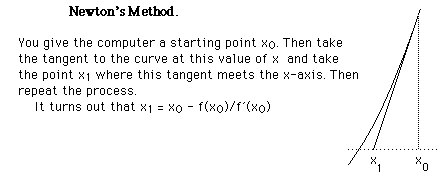| (1) |
| Difference Equations index |
Jacob Bernoulli's "Bernoulli numbers" can be expressed with a recursive relation. Since the Bernoulli numbers are useful in determining the MacLaurin expansion of aeax/(ea - 1), one can show that the Bernoulli numbers have the property that Snk=0 [(an+1k)(Bk)] = 0, where Bk is the kth Bernoulli number and an+1k is the binomial coefficient described below. From this relation it is clear that (an+1n)(Bn) + Sn-1k=0 [(an+1k)(Bk)] = 0. Simple algebra with the identity an+1n = n + 1 shows that Bn = -(n + 1)-1 * Sn-1k=0 [(an+1k)(Bk)]. Therefore, if one starts with B0 = 1, Bn for n > 0 is a linear combination of all preceding Bernoulli numbers.
One can show that B1 = -1/2 is the only Bernoulli number
with an odd subscript. Also, there is a list of some of the nonzero Bernoulli
numbers on the web, but there is considerable disagreement in the indexing
sets used to describe the series of Bernoulli numbers. The site with the
list of Bernoulli numbers starts with B2 but labels it B1.
Subsequent Bernoulli numbers are B2n according to the indexing
definition in the list here
(about halfway down the page).
(Back to top)
Bernoull's Method
In order to find a root of a polynomial equation
| (1) |
which is known to have solution
| (2) |
See also Bernoulli
Number
Abraham de Moivre* had some arithmetic progression.
Arithmetic progression
An arithmetic progression is a sequence ![]() ,
k
= 1, 2, ..., in which each number increases
by the same amount (the common difference)over the previous one.
,
k
= 1, 2, ..., in which each number increases
by the same amount (the common difference)over the previous one.
As for example:5, 8, 11, 14, 17, ...
For a more discussion
of Arithmetic progression and Arithmetic sequence
visit mathworld.wolfram.com
(Back to top)
Sir Isaac Newton
contributed the general binomial formula and a method to approximate the
zeroes of a once differentiable function.
In 1676 he described some examples of expansions of (a+ab)x
(where x is negative or fractional) in letters to the secretary of the
Royal Society to be translated into Latin and forwarded to Leibniz. Newton's
formula for the general binomial formula was given as (a+b)m/n =
am/n + (ab)[m/n] + (bb)[(m-n)/(2n)]
+ (gb)[(m-2n)/(3n)] + (db)[(m-3n)/(4n)]
+ ... In this expression, each greek letter stands for the entire preceeding
term in the expansion (that is, am/n = a,
(ab)[m/n] = b, and
so on). Thus, every expansion of a binomial to a fractional or negative
integer power is the sum of an infinite series. Here the terms of the infinite
series have a recursive relationship from one to the next.
Newton's method for approximating the real roots of a differentiable function uses the tangent line approximation. Consider a differentiable function f(x). Using the tangent line approximation, for a small Dx, f(x+Dx) @ f(x) + f '(x)Dx. If we have an xn close to some real r such that f(r) = 0, then xn+1 = xn - f(xn) / f '(xn) is an even better approximation of r. In fact, {xn} converges to r roughly as the square of n. Unfortunately, Newton's method works only when |x0 - r| is small. If |x0 - r| is too large, then {xn} actually diverges (in this discussion the terms 'sufficiently small' and 'too big' depend heavily on g(x) itself).

Blaise
Pascal did
considerable work with the binomial coefficients, which are frequently
arranged in a format known as Pascal's Triangle. A binomial coefficient ank
is
the coefficient of the akbn-k term in the expansion
of (a+b)n (where n is a nonnegative integer and k
is a nonnegative integer less than or equal to n). Pascal was not the first
to arrange the binomial coefficients in the triangle below, nor was he
the first to notice that the table could be infinitely extended using the
recursive relation ank
= an-1k-1
+
an-1k, which was the first partial difference equation
ever discovered. What he did was the most detailed study of the relationships
between the binomial coefficients. He prove nineteen properties of the
binomial coefficients, for instance. Among these were the symmetry of the
triangle (that is, ank = ann-k)
and ank
= Sni=k
ai-1k-1. He also first published the direct formula
for ank, which is given by ![]() in
modern notation.
in
modern notation.
|
1
|
1
|
1
|
1
|
1
|
1
|
1
|
1
|
1
|
1
|
1
|
|
1
|
2
|
3
|
4
|
5
|
6
|
7
|
8
|
9
|
10
|
|
|
1
|
3
|
6
|
10
|
15
|
21
|
28
|
36
|
45
|
||
|
1
|
4
|
10
|
20
|
35
|
56
|
84
|
120
|
|||
|
1
|
5
|
15
|
35
|
70
|
126
|
210
|
||||
|
1
|
6
|
21
|
56
|
126
|
252
|
|||||
|
1
|
7
|
28
|
84
|
210
|
||||||
|
1
|
8
|
36
|
120
|
|||||||
|
1
|
9
|
45
|
||||||||
|
1
|
10
|
|||||||||
|
1
|
| Difference Equations index |